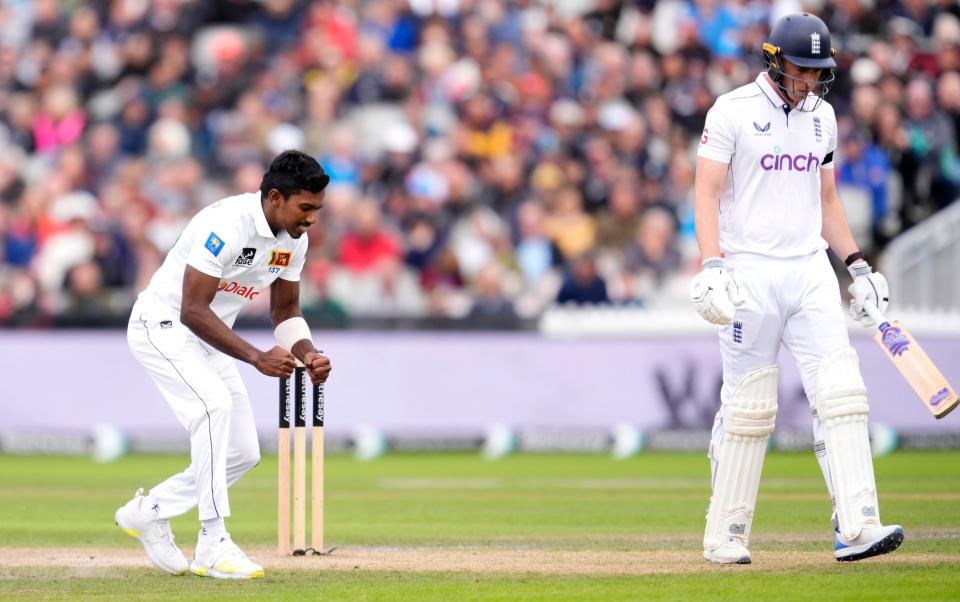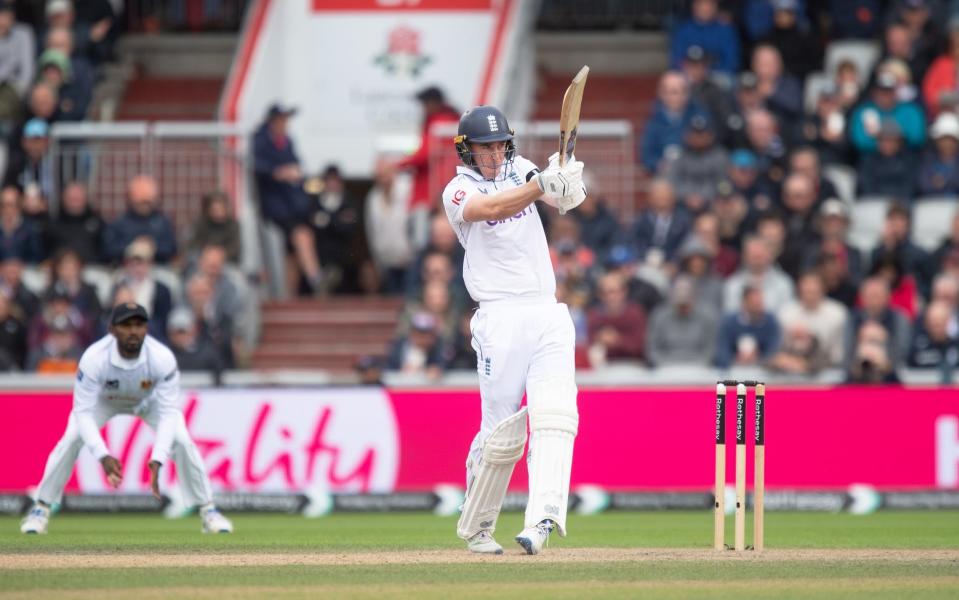
Click here to view this content.
Into the round hole the square peg refused to go. Dan Lawrence has many talents but opening the batting is not one of them. It seldom is for batsmen who distinctly favour the legside.
Lawrence, an “eye player”, is suited to coming in at 200 for three in Pakistan this autumn, or at 300 for four in Australia next winter when the second new ball has begun to soften. He may get lucky and have only a nominal target to knock off in England’s second innings of this Test but, as it stands, Jordan Cox – more compact if equally adventurous – is likely to have made a better fist of opening here.
Opening the batting in this Test against two spinners, as Lawrence had to do on the first evening, is no common experience in England. The last man to do so was another Surrey batsman: not Rory Burns or Dom Sibley, who were busily burying Lancashire at the Oval and cementing Surrey’s status as championship leaders, nor John Edrich, nor even Sir Jack Hobbs, but Tom Hayward back in 1907. So it was a rare opening gambit that Lawrence had to face here.
Rare but not too taxing. In fact the task of opening an innings for England for the first time was made easier for Lawrence precisely because it was against Sri Lanka’s finger-spinners on a grey evening at Old Trafford. Pace bowlers running in with a new ball in fading light would have been no head’s start.
Even so, in these unusual circumstances, Lawrence looked no more than a stop-gap as he took his overnight nine to 30, the highlight a couple of pulls for four.

Zak Crawley might well need sleeping tablets during this match to overcome the pain in his broken finger, but not from anxiety that he will never regain his place alongside Ben Duckett.
Lawrence’s favouring of the legside almost terminated this experiment abruptly on the second morning at the moment Sri Lanka reverted to pace. Urgent in his desire to regain a Test place – at 27 he can see youngsters coming up on the outside rail – Lawrence went to whip a straight one from Asitha Fernando, missed, and desperately sought a review of umpire Paul Reiffel’s decision. The ball was predicted to be going about one inch above the bails.
In the days before Bazball the primary task of an opening batsman in England was not to play the new ball but to leave it. Lawrence, an almost complete stranger to opening, did not have such experience in his skill-set and was caught behind, fiddling at a ball that he could have left, from another Fernando, Vishwa the left-armer, bowling across him.
Of the three Surrey batsmen in this England top six, Ollie Pope was no more numerically successful than Lawrence, but it was an exceptional delivery that seamed back to hit his offstump. Pope’s temperament may still be in doubt at the start of an innings – such is his zeal to feel ball on bat and contribute to his team – but it was not faulty here. If a flaw existed it was in playing slightly across the line.
No such deficiencies were exposed during the innings of the third Surrey batsman in this England line-up. Jamie Smith, when England were wobbling at 125 for four, batted as if he was in his 50th Test, or his 100th, such was his maturity in weighing up the risk of his shot-selections.
In his three previous Tests, Smith had started quietly before unfolding. This time he began breezily, and straight-drove Prabath Jayasuriya for six, before Sri Lanka’s left-arm spinner landed a blow that floored England’s champion-in-the-making Harry Brook. Smith had to factor in this threat and play cautiously forward to stifle it. Chris Woakes paid the penalty for not taking due note and was castled, top of off, by a second super-spinner.
Who will score more Test runs, Brook or Smith? It is a delightful question for England’s supporters to ponder. Brook, for sure, will score his share with more adventurous strokes – trying to sweep a pace bowler here just because the field was set 7-2 was typically daring – while Smith will go for greater orthodoxy, but the latter will be no slouch because his driving is so full-blooded. When driving through the covers, Smith even has the edge over Brook in that he places his front foot closer to the ball, while Brook will throw the bat beyond his eye-line, where judgment gives way to guesswork.
Either way, future Test partnerships between Brook and Smith will be banquets, as delicious to savour as anything in English batsmanship.
Article courtesy of
Source link